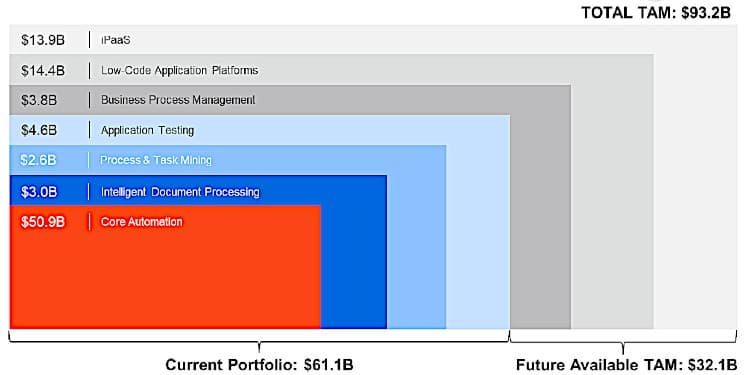The more things change, the more they stay the same. That’s going to be the theme of our article as we do our annual check in with UiPath (PATH), a robotic process automation (RPA) company that just cracked $1 billion in revenue for its wide-ranging automation software for enterprises that does just about everything but the breakroom dishes.
Originally founded in Romania (apparently not where the pope lives) in 2005, UiPath went public two years ago when the markets were still hot. A year later after that IPO, shares of UiPath fell 75% compared to a mere 5% drop across the NYSE, the exchange where UiPath stock trades, over the same time frame. We were kind of puzzled over why UiPath shares had fallen so dramatically given the solid thesis and positive financial metrics. But as you all know, share prices are irrelevant. It all comes down to valuation.
Markets are Down
In our last check in with UiPath a year ago, we speculated that the drop in share price might have been a natural market correction from the pre- and post-IPO hype around UiPath stock. We then calculated that the software company’s valuation at the time aligned with those of its peers. Today, we see the same thing. UiPath sports a simple valuation ratio of 7.5 compared to our catalog average of 6. One might argue it should be trading at a premium since robotic process automation (RPA) should be one of the hottest items in the supermarket when companies look to cut expenses in the face of today’s recession.
We could also make the point that the NYSE is also back to where we started from a year ago in April 2022 – down 5%. In other words, the last 12 months have been a zero-sum gain for everyone, so let’s just move on, right? Just fall back on the trope that tech stocks are just getting killed. After all, the post-SPAC index – which tracks the performance of companies post-merger with blank check firms and includes many new tech stocks – is also down 75% over the last 24 months.
Yet the tech-heavy Invesco QQQ ETF (QQQ) is only under water by 7% over the last two years. So, tech stocks are down, but not lost-three-quarters-of-their-value down. And let’s be clear: UiPath is not a post-SPAC company. Nor is it a politicized company like Palantir or the latest victim recent subject of another short report like C3.ai. It is the market leader in RPA, based on whatever magic quadrant-type report you check.

During our last assessment of UiPath stock, we believed it possessed many of the qualities of the best software-as-a–service (SaaS) stocks. Let’s start by revisiting that assumption.
Is UiPath a SaaS Stock?

UiPath operates an AI-powered platform that helps businesses run a number of processes using software “robots.” Companies can use these busy bits of code to perform a vast array of actions, such as logging into applications, extracting information from documents, moving folders, filling in forms, and updating information fields and databases. The ability to perform these and other actions with greater speed, agility, and accuracy than humans is the value proposition.

For instance, Billed Right, a medical billing and operations company, is using UiPath robots to automate processing healthcare-related data into administrative systems. The solution is expected to save more than 40,000 hours annually. Let’s assume a data-entry clerk makes $15 to $20 per hour, that’s a savings of between $600,000 and $800,000 per year. That’s the bonus pay for one mediocre CEO. Cha-ching.
That sounds like a slam dunk SaaS model to us, where customers subscribe to cloud-based services on an annual basis after they send employees packing to the unemployment line. But it turns out that UiPath actually has a rather convoluted revenue model that it is transitioning to being a more pure SaaS play. (Note that UiPath employs some version of the Mayan calendar and refers to 2022 revenues as 2023 revenues.)

As you can see, about half of revenue comes from on-premise software license contracts that also includes maintenance and support. The other half is from cloud-based software products, with other types of professional services accounting for a small fraction of overall revenue. The company recently introduced what it calls Flex Offerings, packaging both on-premise and cloud software into a single solution that allows customers to choose one or the other throughout the term of the contract. The trend is to move away from licenses to subscription services revenue, so SaaS will grow over time.
Another thing to note. In our past piece on Bargain Hunting Software-as-a-Service Stocks, we looked at how moving a customer from on-premise to cloud-based can result in revenues potentially doubling because the client no longer has to pay all the overheads. All that money being paid to other vendors can now be paid to a single vendor – UiPath. In other words, moving from on-premise to cloud saves firms money.
Key UiPath Metrics
The assumption is that this transition to a SaaS model will boost the bottom line as well, but if you look at the cost of revenue and gross profit, UiPath spends nearly nada to generate nearly half of its revenue from software licenses, but 8% for subscriptions. And it costs another 8% to make 5% in revenue from whatever falls under the category of professional services.

When companies host a solution on-premise, they’re responsible for all the costs except the software license. When a solution is offered via the cloud, there’s the added cost of having to host the solution. So, this seems to be a logical explanation as to why licenses have almost no cost of goods sold (COGS). Of course, the professional services segment is expected to have a high COGS because companies often run these segments at a loss because consultants aren’t cheap. (Usually, this segment involves staff who spend time doing onboarding and helping clients figure out how to use the core products more effectively.) Nonetheless, 83% is an excellent blended gross margin for a software company, regardless of whether we’re talking licenses, subscriptions, or professional services.
Earlier we asked if UiPath was a SaaS stock. The below table helps confirm that holistically it is, as the company aggregates all forms of revenue into an annual run rate number ($1.2 billion as of the end of Fiscal 2023). In looking at their customer revenue buckets, we see solid increases of customers spending more than $1 million and $100,000.

About 75% of ARR growth came from existing customers. The only concerning number above is the net retention rate fell to 123%, though management partly blames exchange rates and Russian sanctions for the drop. Gross retention of 97% shows that customers still like what they’re getting from UiPath.
When Will UiPath Stock Go Up?
This is a question no one would be Foolish enough to try and answer. Currently, it seems harder than it should be to understand how UiPath slices and dices its revenue. It was only in 2020 (or 2021 in the UiPath Mayan calendar) when the company introduced what it called its hybrid offerings, which are being replaced by Flex Offerings. Investors want simple-to-understand metrics and not a revolving carousel of revenue options from one year to the next. Hopefully, the company is shifting to cloud subscriptions becoming the norm over time, a transition that should result in increased revenues on its own.
Regardless, there is nothing disconcerting about the underlying financials, with fiscal year 2024 projections of revenue coming in at about $1.25 billion which represents growth of about 25% for this year (up from last year’s revenue growth of 18%). UiPath has zero debt, $1.76 billion in cash, and is steadily trimming losses while maintaining growth, with a substantial international footprint.

Another possibility is that the hype around generative AI with ChatGPT simply has investors overlooking UiPath, despite its own AI bonafides. The company already uses AI to build large language models for capabilities like Document Understanding. It recently required an AI startup called Re:infer for more than $44 million in cash and stock.
Re:infer uses machine learning to mine context from communications. One customer just signed up to use the technology to “interpret customer sentiment across millions of emails per year to reduce manual processing, client churn, and enhance customer experience.” In addition, UiPath is rolling out something called Clipboard AI, which combines UiPath AI with large language models like ChatGPT to intelligently transfer data between documents, spreadsheets, and apps, eliminating the need for endless copy and paste. Eventually, UiPath’s software robots will be able to write content, generate responses, and fire human employees as part of the workflow. The total addressable market for RPA is huge.

UiPath on the generative AI hype train? Check.
Conclusion
Once again, we are a bit puzzled by the lack of investor enthusiasm for UiPath stock, given the continued revenue growth, the strong value proposition, and the company’s leading market position and technology innovation. It may just boil down to investors remaining gun-shy on less well-established public tech companies, lumping them together in the SPACtacular mess that blank check schemes created over the last few years. This creates an opportunity for investors to grab shares of UiPath stock at reasonable, if not bargain, valuations.
Tech investing is extremely risky. Minimize your risk with our stock research, investment tools, and portfolios, and find out which tech stocks you should avoid. Become a Nanalyze Premium member and find out today!










![No beef with Pat McAfee despite reports [Update] No beef with Pat McAfee despite reports [Update]](https://i.kinja-img.com/image/upload/c_fill,h_675,pg_1,q_80,w_1200/157b62f1429f3465c2595a6f2ccef67e.png)






